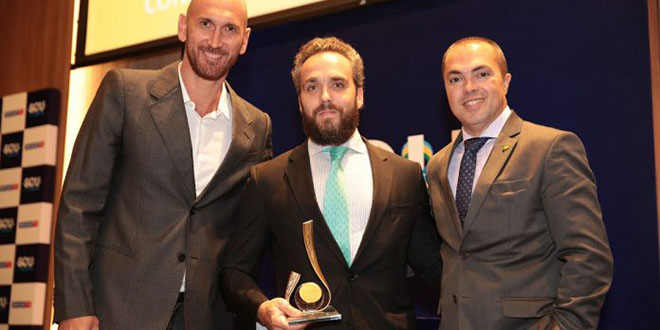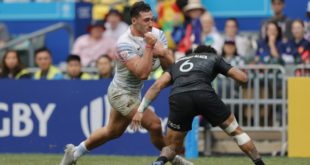Brazilian rugby has developed significantly in recent years. Americas Rugby News caught up with the CBRu CEO Agustín Danza to get insight into what is behind the progress and what to look forward to in the future from Brazil.
How has the Americas Rugby Championship (ARC) changed the shape of Brazilian Men’s Rugby?
The ARC was fundamental for Brazil to be able to be able to take the next step in terms of XV’s High Performance. The High Performance system has been in place since May of 2015, with, for the first time, hundreds of players training daily in six High Performance centers. It was fundamental to obtain the High Performance competition to complement the intensity of the training, given that only by playing is it possible to fully develop a player. The ARC allowed us the guarantee of five games above us in the ranking for five years.
Victories have come against Canada, and the USA. Against Chile they have been not only with regularity but as a constant. What is the explanation for this?
The victories are a consequence of the planned and very well executed work that has been taking place in the gyms, both by the staff and by the players. Granted, every win has a small component of good fortune too, but if the team was not sufficiently well trained they could not take advantage in this moment of luck.
Beginning from the moment in which we opened the six High Performance Centers, we have increased our capacity to detect and the develop players. The work done in the system has focused heavily on the preparation of the individual athletes, significantly improving their strength and conditioning and their individual skills.
At the same time we started a project to bring back a variety of players to Brazil who were born here but went to live in rugby countries. They were also inserted into the High Performance system.
Together these factors have enabled us to rapidly grow into having a much larger player base, with technical and physical conditions that we never previously had. This enabled us to establish a stable platform to challenge better teams.
Brazil vs Maori All Blacks in November. What are the goals for the occasion off the field?
The match has two broad off-field objectives. The first is to significantly increase the exposure of rugby in Brazil. The Maori All Blacks are a brand that many people know of without necessarily knowing about rugby. We hope to be able to captivate many Brazilians with the intensity and quality of the game, both on the field and off it.
The second is to demonstrate to the market the commercial attractiveness that Brazil Rugby has for companies, for the values of the sport and the talent of the team and quality of the event.
Brazil did not play in the June Internationals this year. Is there a structure for this to change for the 2020-2022 years?
The reason for which we did not play test matches in the June Window is that all of our potential rivals were directly or indirectly affected by the disqualification of various European countries from the RWC 2019 qualifying tournament.
Unfortunately there was no available team to travel to Brazil or to receive us away. It is because of this that we decided to play in the Rugby Summer tournament in Georgia, for which we are extremely grateful to the Georgian Rugby Union for the invitation.
The CBRu has stated RWC 2023 as the goal for Brazil. Is qualifying a realistic dream?
Absolutely! We are convinced that we can qualify. Like any ambition, it must be realistic but also challenging, of us to always give it our all. It will not be easy, it is far from being guaranteed. In fact today we are not favorites to qualify. But we have demonstrated over the recent years that the level of Brazil is still far from peaking and that we still have so much to achieve. And this is what we work for each and every day.
Uruguay and the USA qualified for RWC 2019 ahead of Canada. Russia will play due to Romania and Spain being disqualified. Portugal played at RWC 2007. Brazil is comparable to or within reach of many of these countries. Should there be 24 teams at RWCs?
We believe that every year we are becoming increasingly comparable to these teams, but that we still need to work to reach the same level. However, the progress that we have had in the last two years demonstrates that we can get there.
However, your question is a very good one. We feel that World Rugby should begin to seriously analyze expanding the RWC to 24 teams. We understand the concerns of World Rugby, to avoid lop-sided score lines and games without appeal. Nonetheless, there are constantly more countries from the Tier 2 and 3 that are improving their performance: Germany, Spain, Russia, Brazil, Uruguay, USA, and Kenya among others.
Professionalism is vital to reaching a RWC. Will os Tupis be the same players in Brazil’s in the Liga-Sul Americana and where are these teams going to be based?
Yes, os Tupis will play in the Liga Americana de Rugby. We still have not confirmed the locations, we are working on some options. But we agree with your vision that professionalism is very important to improve the High Performance.
Is Men’s 7’s less of a priority now than in the past?
The Men’s 7’s has an important role, which is the development of players in the High Performance center to eventually make it to XV’s. At the same time, and during this process, we are identifying players with specific characteristics for 7’s. We aim to have a competitive team for Paris 2014.
The Women’s 7’s side are extremely successful in South American competition. When would it be plausible for Brazil to play in a Women’s RWC?
We would love to have a Women’s XV’s team that could eventually compete at a Women’s RWC. However today there is still not a path for a South American country to get to the Women’s RWC. We need the Women’s XV’s to grow in the region, to be able to compete regionally, develop the players and with this lay a road to the RWC. Some talks in this sense have already begun.
Brazil’s national domestic competition has been expanded and rebranded. It is now the Super 16. While the season is young the results indicate a difference in abilities within the four pools. Why was this model chosen and should it continue in future years?
The model was chosen as a result of a year’s work with the 12 top Brazilian clubs. The model was chosen for a number of reasons. The first is because it is the best way to be able to have a truly national tournament over an extended period of time. It is the model that all of the countries of continental size, like Brazil, have due to the transport difficulties that a country of this size represents. Thanks to the regional model we are able to think of having groups in Brazil’s MidWest or Northeast in the short / medium term.
Another objective is to have an expanded tournament that allows teams that have been working hard to develop faster, a consequence of playing against better teams. For example when Jacareí entered the 1st division they lost by more than 100 points to Pasteur. Five years later they were the national champions. Another example is Japan in the RWC, in that they lost by a record score vs New Zealand (145-17 in RWC 1995) and six RWCs later they defeated South Africa in the most recent tournament.
In this sense, I am very satisfied with the scores that we have had so far. There are clubs including Charrua, Pé Vermelho, Niterói, and San Diego who are demonstrating excellent conditions to be able to face the challenge and grow even further. Their matches were very tough against rivals who have been Brazilian finalists for example. The other clubs are clearly pushing hard and I believe that they will get better.
This is the beginning of a long-term process in which we should be patient and pay attention to how these teams develop. Of course we will have some setbacks, they happen in all processes, but we should always evaluate the overall balance and not forget the final objective, which is to have a tournament which is representative of Brazil, with multiple regions distributed throughout the country.
Agustín Danza is the CEO of the Confederação Brasileira de Rugby (CBRu – Brazilian Rugby Confederation). In the role since February 2014 he is responsible for designing and implementing the 1st long term strategy of the union. He played rugby for more than 20 years in Argentina. Follow Agustín on Twitter @adanza82
 Americas Rugby News Rugby news from across the Americas!
Americas Rugby News Rugby news from across the Americas!




